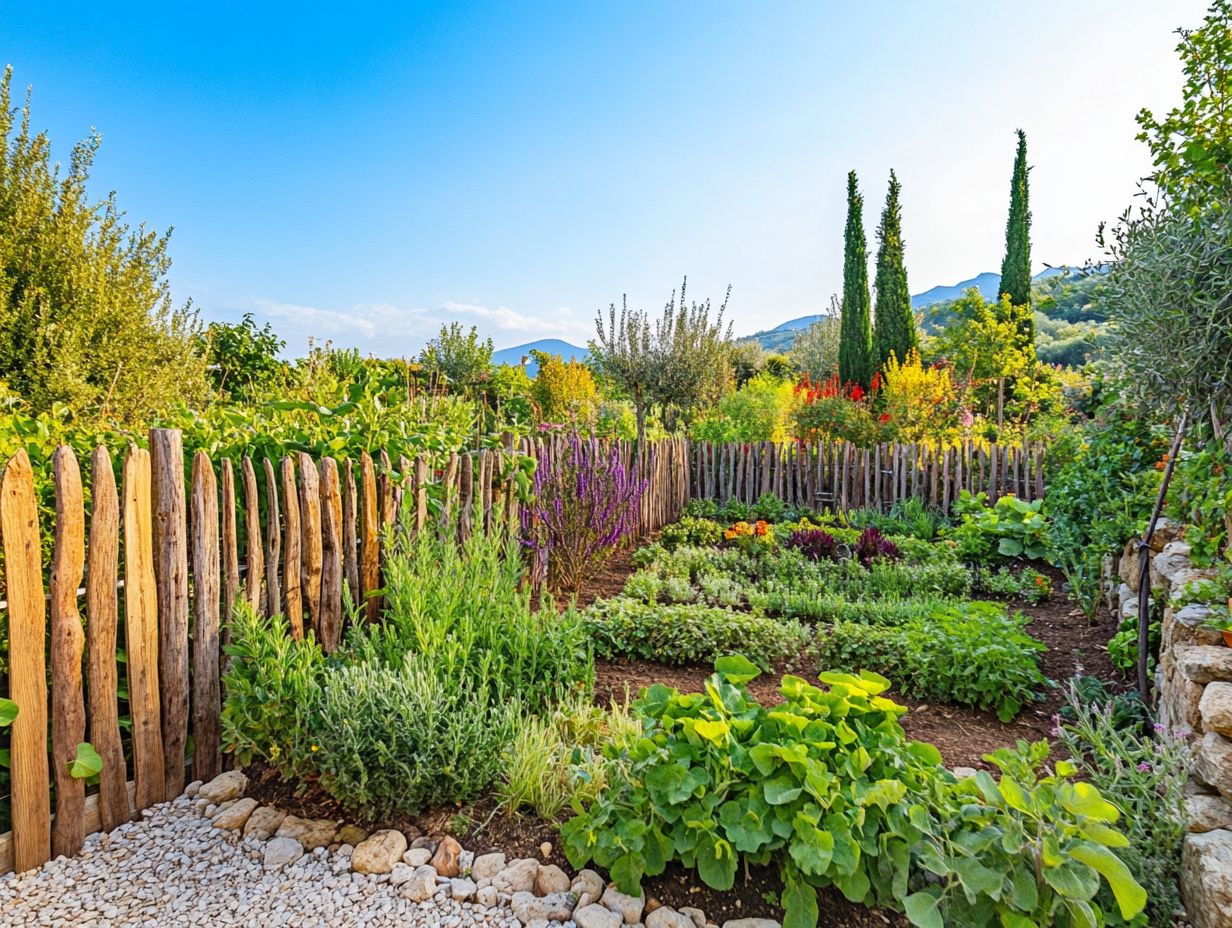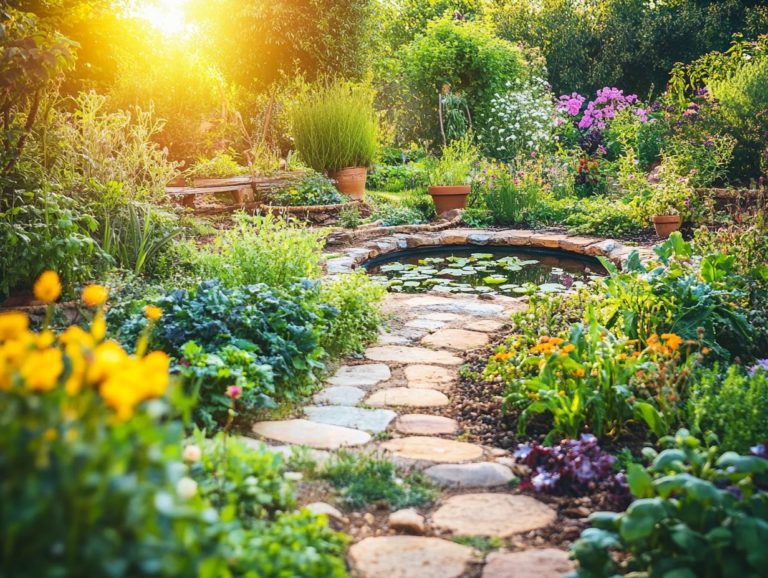The Role of Fencing in Permaculture Design
Discover how fencing can transform your permaculture journey! Living fences not only protect your plants but also bring vibrant life to your ecosystem. Permaculture focuses on creating sustainable ecosystems that work in harmony with nature. Fencing, especially living fences, is a vital part of this philosophy.
It safeguards your plants and animals while simultaneously boosting the overall soil health and ecological balance of your ecosystem. This article delves into the fundamentals of permaculture, highlighting the significance of fencing, specifically living fences, and the diverse materials at your disposal.
You’ll also explore key considerations for selecting the right fencing, including privacy screens and seasonal guards, along with tips for optimal design and best practices for maintenance. Discover the essential elements of integrating fencing into your permaculture strategy for a flourishing environment, emphasizing habitat creation and community participation.
Contents
- Key Takeaways:
- The Basics of Permaculture Design
- The Importance of Fencing in Permaculture
- Types of Fences Used in Permaculture
- Factors to Consider When Choosing Fencing
- Designing Fencing for Optimal Functionality
- Maintaining and Repairing Fences in Permaculture
- Frequently Asked Questions
- What is the role of fencing in permaculture design?
- Can fencing be beneficial for wildlife in permaculture design?
- What materials are commonly used for fencing in permaculture design?
- How can fencing contribute to soil health in permaculture design?
- Are there any downsides to using fencing in permaculture design?
- What are some creative ways to incorporate fencing in permaculture design?
Key Takeaways:

- Fencing plays a crucial role in protecting and enhancing the ecosystem in permaculture design.
- When choosing fencing materials, it is important to consider factors such as climate, soil, and plant needs.
- Proper design and maintenance of fences are essential for optimal functionality and long-term sustainability in permaculture.
The Basics of Permaculture Design
Permaculture design is an exquisite approach that harmonizes land, resources, people, and the environment in a sustainable manner. It incorporates indigenous culture and sustainable landscaping principles. It emphasizes independence in growing food and ecological balance, employing permaculture principles that foster systems supporting biodiversity, such as living fences, and nurturing habitat creation.
In this context, community participation is crucial for sharing knowledge and resources. This makes sustainable practices accessible, enriching the ecosystem.
Defining Permaculture and its Principles
Permaculture is a captivating design philosophy centered on sustainable agriculture and ecological harmony. It is built upon principles that promote independence in growing food, living fences, and regenerative practices (methods that restore and maintain the health of ecosystems).
Rooted in the 1970s, it emerged as a thoughtful response to the environmental consequences of industrial farming. This holistic approach draws insights from various fields, including ecology, agriculture, and landscape design, integrating concepts like biodiversity and habitat creation. At its essence, permaculture champions the idea of mimicking natural ecosystems to cultivate resilient agricultural systems that enhance biodiversity.
Key principles encompass:
- Observing and interacting with nature
- Understanding the benefits of biodiversity
- Utilizing renewable resources effectively
By thoughtfully integrating plants, animals, and natural processes, including using edible species, you can manage resources efficiently while enhancing soil health and conserving water. This interconnected approach not only fosters sustainability but also cultivates a thriving environment that benefits all living beings and promotes healthy ecosystems.
The Importance of Fencing in Permaculture
Fencing holds significant importance in permaculture, offering not just security but also a boost to biodiversity through living fences and a contribution to a self-sufficient ecosystem.
Living fences serve as privacy screens while simultaneously acting as windbreaks. They effectively reduce noise pollution, support plants, and shield crops from harsh weather elements like winter winds.
These ecological structures also provide economic benefits by supplying resources like timber, fruits, and medicinal plants, including giloy and butterfly pea. This fosters a sustainable cycle that benefits both the environment and your livelihood.
Start integrating these fencing strategies today for a thriving permaculture garden!
Protecting and Enhancing the Ecosystem
Fencing in permaculture is crucial for safeguarding and enhancing the ecosystem. It establishes boundaries that encourage habitat creation and biodiversity, particularly with living fences, while also considering the role of plants in permaculture design.
By incorporating thoughtfully designed living fences, you can create safe havens for various wildlife species like birds and beneficial insects. This fosters a vibrant tapestry of life within your garden.
Consider living fences made from an array of plant species such as hawthorn, blackthorn, elderberry, and Jatropha. These plants offer food and shelter for birds and beneficial insects. They also improve soil health, reduce soil erosion, and support nitrogen fixation, a process that helps plants grow.
This diverse flora doesn t just attract pollinators like bees and butterflies; it also lures in predatory insects that help control pests naturally. The result? A balanced ecosystem where both flora and fauna can thrive, creating a flourishing environment that benefits everyone involved.
Types of Fences Used in Permaculture

In permaculture, a variety of fencing options are available, but living fences stand out as a favored choice. They offer multifunctionality, support biodiversity, and provide aesthetic charm.
These innovative barriers consist of diverse plant species, such as mulberries and other edible species. They not only mark property lines but also serve as economic assets, yielding seasonal produce.
Furthermore, these plants provide crucial ecological benefits, such as creating habitats for wildlife.
Choosing living fences is an exciting step towards sustainability, biodiversity, and community participation, key principles at the heart of permaculture practices.
Comparing Different Materials
When exploring materials for fencing in permaculture, living fences truly shine. They foster ecological balance while embracing sustainable materials and supporting biodiversity.
Unlike traditional options like wood or metal, which often require high-energy production and can lead to deforestation or habitat loss, living fences incorporate native plants and edible species that boost biodiversity.
These green barriers provide wildlife with shelter and food. They also help improve soil health and reduce soil erosion through their intricate root systems.
While traditional fences may need regular maintenance, like painting or repairs, living fences require a different approach think occasional pruning or replanting. This can be much more environmentally friendly and promote regeneration.
Though they may take longer to establish and might not provide instant privacy or security like conventional options, their long-term benefits to biodiversity and community participation are invaluable. Ultimately, each option has its advantages, and the choice depends on your commitment to ecological harmony, community involvement, and specific functional needs.
Factors to Consider When Choosing Fencing
Selecting the ideal fencing for permaculture requires thoughtful consideration of various factors, including climate, soil conditions, and the unique requirements of your plants.
Understanding your local climate will guide your choice of materials. Evaluating soil health is essential for establishing living fences that enhance biodiversity and support healthy ecosystems.
Don t forget to consider noise reduction, windbreaks, and the contribution of living fences. These elements play crucial roles in fostering a healthier ecosystem and supporting more productive agricultural practices.
Climate, Soil, and Plant Needs
Understanding the relationship between climate, soil health, and plant needs is crucial when choosing fencing materials for permaculture. This is especially important in tropical zones and arid regions.
For those in arid areas, choosing drought-resistant species like Acacia concinna ensures your living fences thrive even with little water. In humid climates, you can select from a diverse range of plants that need a lot of water, like Giloy and butterfly pea.
The significance of healthy soil is paramount. Rich, nutrient-dense substrates promote vigorous root growth and resilience, ultimately maintaining the integrity and functionality of your green barriers while providing economic benefits.
Integrating local ecological knowledge, including indigenous culture, into your selection process not only enhances the durability of your living fences but also helps your community create habitats that support biodiversity and positively impact the surrounding environment.
Designing Fencing for Optimal Functionality
Designing fencing for optimal functionality requires you to think about the strategic placement of living fences and how they fit into various elements of your permaculture system. This approach maximizes benefits like biodiversity, soil health, and community engagement.
By carefully selecting and arranging living fences, you create a beautiful and practical ensemble that enhances ecological balance, supports wildlife, and beautifies your landscape. This meticulous design process elevates the aesthetic appeal and promotes sustainable landscaping practices, ensuring your efforts make a positive impact on the environment.
Placement and Integration with Other Elements

In permaculture design, the placement of fencing, particularly living fences, is essential. It defines how effectively your system integrates with other elements and enhances biodiversity.
Strategically positioned fences, especially living ones, can serve as windbreaks, providing shelter for your crops and encouraging beneficial insect populations. By arranging hedgerows and including diverse plant species, you create dedicated spaces for pollinators and other wildlife, fostering a more resilient ecosystem.
Fencing can also guide livestock to support rotational grazing. This practice promotes soil health, nutrient cycling, and sustainability. You might use movable fencing to create paddocks, allowing your plants and seasonal produce to recover while preventing overgrazing.
These integrated designs not only boost plant growth but also create habitats for birds and small mammals. This cultivates a balanced environment that nurtures diverse life forms while enhancing agricultural practices and promoting habitat creation.
Maintaining and Repairing Fences in Permaculture
Maintaining and repairing fences in permaculture is crucial for achieving long-term sustainability and fostering ecosystem regeneration, adhering to permaculture principles. Regular upkeep safeguards the structural integrity of your fences and bolsters the biodiversity these living structures support.
By adopting sustainable practices in your maintenance routine, you can enhance ecological balance. This ensures your fences continue to provide their many benefits over time while promoting community participation.
Best Practices for Long-Term Sustainability
Implementing best practices for long-term sustainability in fence maintenance is crucial for ensuring the health of the environment, promoting biodiversity, and supporting economic providers.
By engaging in regular plant care for your living fences, you can significantly enhance soil health and create habitats for various wildlife species. This includes medicinal plants like giloy and butterfly pea. Periodic pruning is essential; it maintains the aesthetic appeal of your fences and encourages strong growth and resilience against pests. This also contributes to the overall beautification of your space.
For traditional fences, routine material checks are equally important, particularly when considering options like Acacia concinna and Jatropha, which are types of plants. Identifying signs of wear and tear allows you to prevent premature replacement and reduce waste. This approach helps minimize noise pollution in your surroundings.
By addressing these concerns, you not only extend the lifespan of your structures but also minimize your environmental footprint. This fosters a more balanced environment for future generations and mitigates soil erosion.
Frequently Asked Questions
What is the role of fencing in permaculture design?
Fencing in permaculture design serves multiple purposes:
- Protecting crops from livestock
- Creating privacy screens
- Delineating different zones within a permaculture system
Can fencing be beneficial for wildlife in permaculture design?

Yes! Fencing can be designed to benefit wildlife by:
- Creating corridors for animals to move through
- Providing habitat for beneficial insects
- Protecting vulnerable plants from being eaten
This contributes to healthy ecosystems.
What materials are commonly used for fencing in permaculture design?
Common materials include:
- Natural wood
- Bamboo
- Recycled metals
- Seasonal produce
- Living plants
- Traditional wire or mesh
The choice of material depends on the specific needs and goals of the permaculture system, including considerations for urban homes and rural farming.
How can fencing contribute to soil health in permaculture design?
Fencing can be used strategically to control animal grazing and movement, helping to prevent soil erosion and compaction. It serves as effective windbreaks during winter winds. Fencing can also protect and nurture edible species and microorganisms that enhance soil health.
Are there any downsides to using fencing in permaculture design?
While fencing can be a useful tool, it is important to consider potential negative impacts, such as:
- Risks to wildlife and the environment
- Possibility of noise pollution
- Costs and labor intensity for installation and maintenance
What are some creative ways to incorporate fencing in permaculture design?
Fencing can be incorporated in various ways, such as:
- Using living plants as fencing
- Creating trellises for climbing plants
- Building fences with recycled or salvaged materials
This supports sustainable landscaping and can enhance community engagement and participation. Learn more about sustainable practices today!






